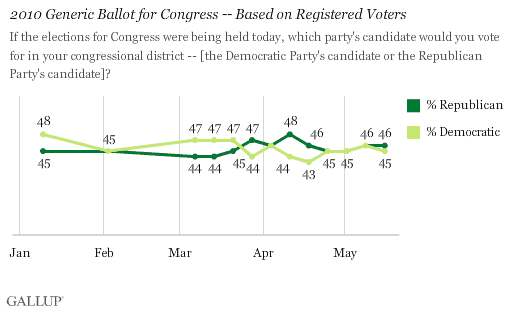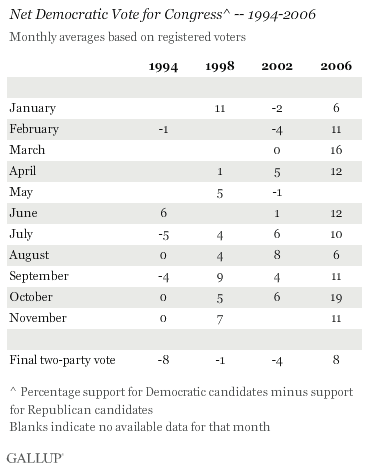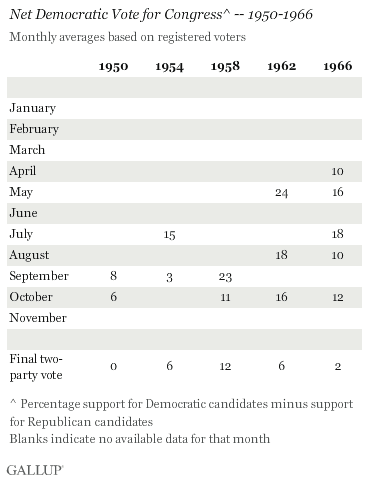PRINCETON, NJ -- Gallup Daily tracking for the week ending May 16 finds the two major political parties essentially tied in the congressional voting preferences of registered voters nationally. Of voters surveyed, 46% favor Republican candidates and 45% Democratic candidates.

This is the eighth straight week that support for Republican candidates matches or exceeds support for Democratic candidates, and it is line with the rough parity between the two parties seen since January.
Historically, Republicans have had a significant turnout advantage in midterm elections, shifting the gap in voter support for the two parties by five percentage points, on average, in their direction. This means that if Republican and Democratic candidates still enjoy equal support from all registered voters by Election Day, Republican candidates would most likely receive a higher percentage of the actual votes cast, given the typical 40% voter turnout rate. Republicans would also be virtually guaranteed major seat gains, possibly putting them in range of recapturing majority control of the U.S. House.
Stability Is the Name of the Game
With six months remaining before the election, it is too soon to be making such predictions -- Gallup typically does not begin to identify likely voters and measure probable turnout until the fall of a midterm election year. However, history does suggest that the underlying voting preferences in place today are more likely than not to continue.
According to Gallup generic ballot trends for each midterm election from 1950-2006 (excluding 1986 for which limited trends are available), the structure of voting preferences seen in the first three months of the year generally carried through to the end.
In recent years, the only twist on that came in 2002. While the Republicans won that election, and Republicans enjoyed an edge in voter support at the beginning of the year, support for the Democrats increased in the summer and fall, suggesting a possible turnaround for that party. However, any real gain in voter support by the Democrats either was not maintained through the end, or it was not enough to compensate for the Republicans' turnout advantage.

The midterm elections from 1970 to 1990 all resulted in solid Democratic control of the U.S. House of Representatives. The Democrats' ultimate advantage in the national two-party vote in each of these elections was previewed early on in each election year.

Prior to 1970, the earliest Gallup generic ballots in each midterm year were not conducted until April or later. However, for the most part, Gallup's polls showed the Democrats leading, consistent with the final outcome in all of those years.

Implications
The competitive nature of the vote for Congress among all registered voters today is highly positive for the Republicans. Not only do Gallup trends suggest this would likely translate into a GOP lead among actual voters if the election were held today, but there is a certain amount of inertia to these numbers. Unless something happens to significantly alter the political environment, the odds are that preferences among registered voters will continue to be closely split in the coming months.
Results are based on telephone interviews with a random sample of 1,574 registered voters, aged 18 and older, conducted May 10-16, 2010 as part of Gallup Daily tracking. For results based on the total sample of national adults, one can say with 95% confidence that the maximum margin of sampling error is ±3 percentage points.
Interviews are conducted with respondents on landline telephones (for respondents with a landline telephone) and cellular phones (for respondents who are cell phone only).
In addition to sampling error, question wording and practical difficulties in conducting surveys can introduce error or bias into the findings of public opinion polls.
